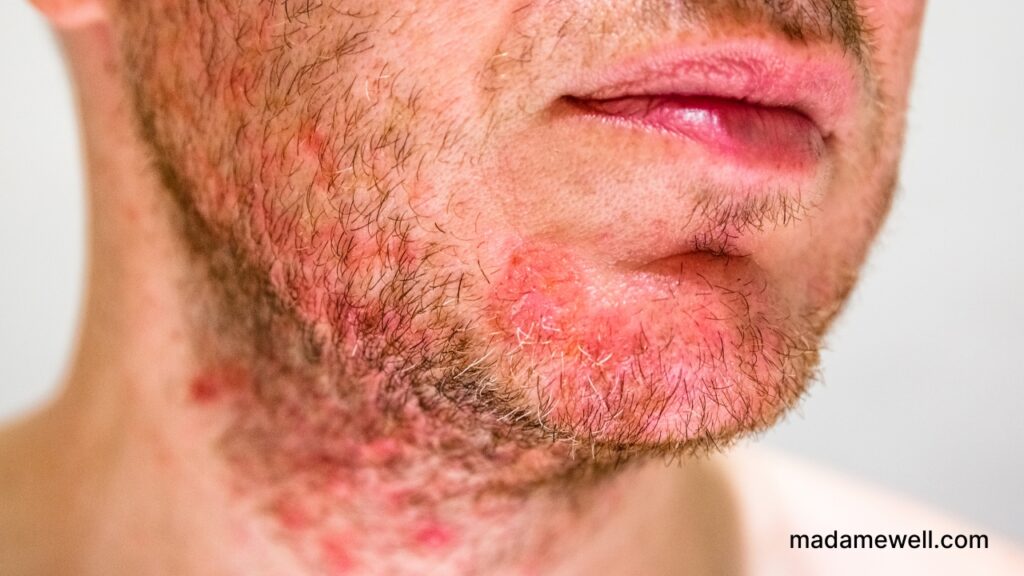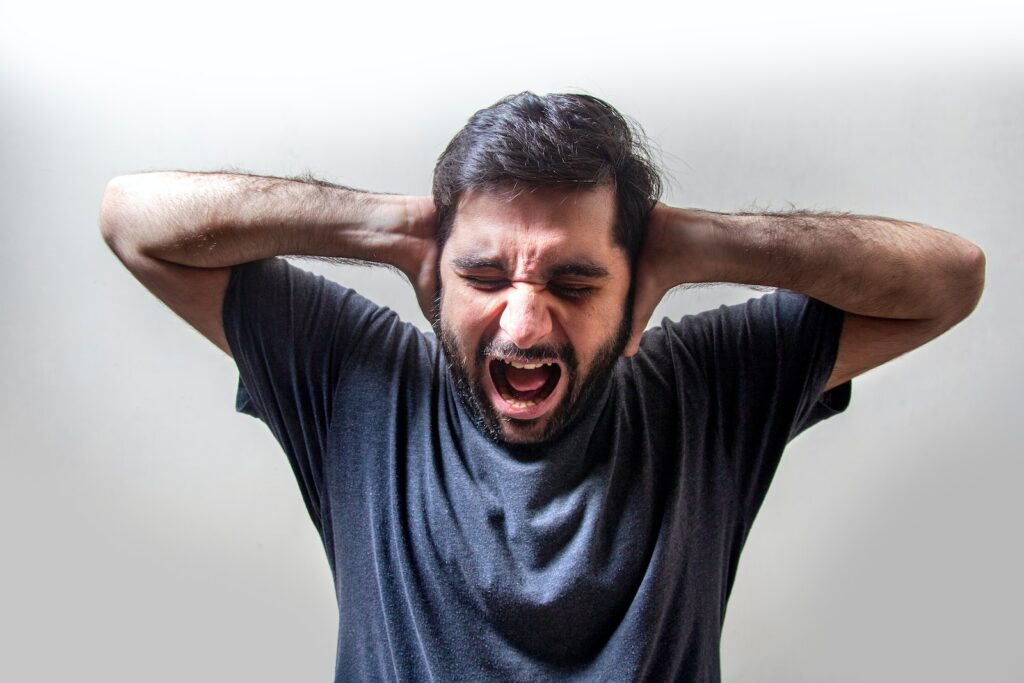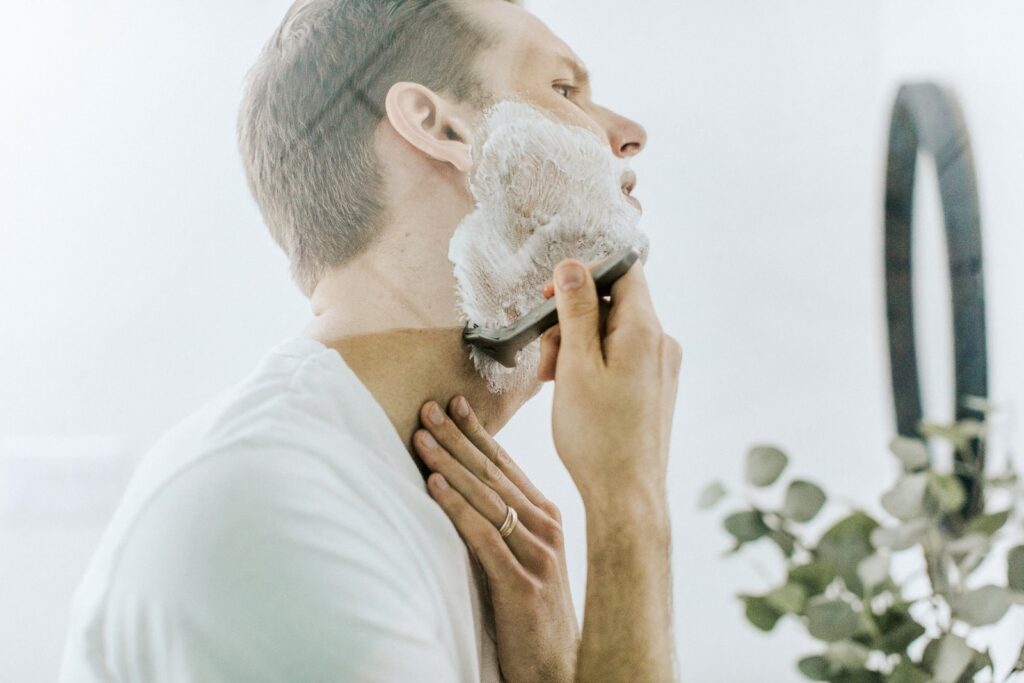Flaky, itchy beards are an annoying and embarassing problem for many men. This condition, known as beard dandruff or “beardruff”, is essentially a form of seborrheic dermatitis that occurs specifically in facial hair.
Beard dandruff is caused by overgrowth of a yeast called Malassezia that lives on everyone’s skin. The yeast feeds on oils secreted by hair follicles, and the metabolic byproducts of process irritate the skin and cause flaking.
Luckily, with the right skin care regimen, men can get beard dandruff under control.
Let’s take a deep dive:
Symptoms of Beard Seborrheic Dermatitis

The hallmark symptom of beard dandruff is flaking or scaling of the skin under the beard. These small white or yellow flakes are visible in the beard hair and may also fall onto the shoulders.
Itching is another common symptom. This may be accompanied by inflammation, which can appear as patches of red, inflamed skin on the neck, jawline, and cheeks beneath the facial hair.
The area may feel sensitive or sore to the touch. The skin underneath your beard can also feel greasy and small yellow crusts appear. Your beard hair may feel dry and brittle.
Differentiating from Related Conditions
It’s sometimes difficult to distinguish beard seborrheic dermatitis from other skin conditions, especially eczema, psoriasis, or rosacea, which can present with overlapping symptoms. Generally speaking:
- Seborrheic dermatitis typically leads to oily, flaky patches, while eczema generally results in dry, sensitive skin.
- Psoriasis often involves thicker, more defined scales than those seen with seborrheic dermatitis. Psoriasis also often occurs on elbows, knees, and scalp along with the beard area.
- Rosacea mainly affects the skin with flushing and visible blood vessels, usually without the dandruff-like scaling.
- Contact dermatitis is usually caused by an allergy to a product ingredient and appears as a red, itchy rash in recently exposed areas (check out Seborrheic Dermatitis vs Eczema: Key Differences Explained)
- Ringworm causes a circular rash with scaly borders and clearing in the center. Can cause hair loss in affected area.
- Folliculitis causes small red bumps with white pus caused by infection of hair follicle. It’s usually painful to touch.
- Head lice – With head lice you’ll be able to see visible crawling insects in your beard hair. Lice causes intense itching, especially at night and you may see nits stuck to beard hair shafts.
- If you have dry skin (and not Seb Derm), you may have generalized flaking without associated redness or itching. There will be no underlying skin changes and moisturizing your beard takes care of the symptoms in a jiffy.
If you’re unsure about your symptoms, see a healthcare provider to obtain the correct diagnosis. You need to know what you’re dealing with to manage the condition properly.
Causes and Triggers of Beard Seborrheic Dermatitis
Understanding the underlying factors that lead to the development of seborrheic dermatitis in the beard area is key to managing this condition. The main causes and triggers, similar to Seb Derm elsewhere on your body, revolve around Malassezia proliferation, hormonal influences, stress, and environmental factors.
Yeast and Skin Flora
Your skin naturally hosts a variety of microorganisms, including a yeast called Malassezia. In seborrheic dermatitis, microbiome imbalance and Malassezia overpopulation, particularly in oily skin areas, leading to irritation and flaking as Malassezia thrives on the oils secreted by your sebaceous glands.
Hormonal Factors
Your hormones can contribute to beard seb derm in a few key ways:
- Androgens like testosterone and DHT increase sebum production, providing nourishment for Malassezia
- High stress hormone levels like cortisol increases sebum production and suppresses your immune system’s ability to control Malassezia overgrowth.
- Puberty – in puberty, the increase in androgens like testosterone increases sebum production
- Menstruation, pregnancy and menopause also affects Seb Derm but luckily, you don’t have to deal with these issues.
Stress

When we are stressed, our bodies release higher levels of hormones like cortisol and adrenaline. This stress response causes increase in sebum production and impairs your immune system, allowing Malassezia to grow. Stress also increases inflammation, which can worsen the irritation and flaking.
Weather and Environment
Low humidity and cold winter weather can dry out the skin under your beard, causing flaking and itchiness. The dry air draws moisture out of the skin, damaging the skin barrier.
On the other hand, hot and humid weather causes you to sweat. The moisture gets trapped in your beard hair follicles, promoting fungal and bacterial growth.
Environmental pollutants can collect in your beard and absorb into your skin, causing oxidative stress and inflammation. This disrupts the skin microbiome balance, further exacerbating Malassezia.
Lack of sun exposure, low Vitamin D Levels, washing with hard water, and other lifestyle factors can also damage the skin, alter the microbiome balance and provide conditions that encourage beard dandruff.
Improper Beard Care
This is a biggie. Lots of men don’t take care of their beard properly and end up with beard dandruff. Fortunately, once you know how to care for your beard, it’s easy to manage your symptoms. These are some of the ways improper beard care can contribute to beard seb derm:
- Not washing regularly enough allows dead skin cells, oil, and product buildup to accumulate which irritates your skin and clogs follicles.
- Washing too frequently strips natural oils and dries out your skin and beard hair. This can trigger an overproduction of sebum.
- Harsh cleansers with sulfates and fragrances can disrupt skin’s protective barrier and microbiome. This leaves your skin prone to inflammation and Malassezia overgrowth.
- If you don’t rinse properly after cleansing, the leftover residue can irritate your skin, causing flaking and itching.
- Not moisturizing your beard causes dry, flaky skin and brittle beard hair.
- Moisturizing with the wrong products worsen beard dandruff. Did you know most beard oils and balms contain oils that feed Malassezia? These were the only beard balms I found that are safe for Seb Derm: The 4 Best Beard Balms for Seborrheic Dermatitis
- When you don’t brush or comb your beard, you allow tangles which prevents proper distribution of oils.
How To Get Rid Of Beard Dandruff
Thankfully, there are lots you can do to take control of beard Seb Derm. It starts with a good beard care routine:
Cleanse regularly

Use an anti-fungal shampoo like Nizoral or Head & Shoulders to cleanse your beard several times a week. If you find the shampoos too irritating, dilute it with water first before applying to your beard area.
If you prefer a more natural option or want to use the regular beard shampoo you already have at home, dilute a few drops of tea tree oil with your cleanser and cleanse as usual.
Exfoliate

Exfoliating regularly not only helps in alleviating dandruff but also promotes a healthy beard growth. Use a beard scrub 2-3 times a week. Look for gentle scrubs with exfoliating ingredients like jojoba beads, sea salt, or crushed almonds. Massage into your damp beard and rinse thoroughly.
I recommend using a salicylic acid exfoliant, especially if you have flaky skin.
You can also use a beard brush or wet washcloth.
Anti-fungal Cream

Anti-fungal creams like Clotrimazole work wonders on Seb Derm of the face, neck and elsewhere on your body. If cleansing with an anti-fungal shampoo a few times a week isn’t cutting it, apply an anti-fungal cream to the skin under your beard area twice a day for 2 weeks.
It’s tricky, but if you use small amounts at a time and rub the cream into your skin until it’s absorbed, it won’t stick onto your beard hair.
Moisturize

The best way to moisturize your beard is to apply a beard oil or balm daily after showering. Look for oils that don’t feed Malassezia like jojoba, MCT or squalane oil. After patting your beard dry, rub a few drops of oil between your palms to warm it up before working it into your facial hair from root to tip. Use a boar bristle brush to evenly distribute the oil throughout your beard.
For longer beards, focus on the skin underneath by massaging oil into the follicles. The oil conditions individual hairs, softening them while hydrating the skin to prevent flaking. Oils with clove or tea tree oil provide extra nourishment and dandruff relief.
It’s nye impossible to find beard balms that are safe for Seb Derm, but these are my 4 top picks.
Shave…?
The simple act of shaving can be painful when you have seb derm. The friction and irritation caused by razors or shavers can scrape and inflame the already sensitive skin patches. This can worsen your Seb Derm flare.
To reduce irritation from shaving, use an electric razor with a safety guard, apply a soothing shave gel or cream, avoid pressing too hard, and shave in the direction of the hair growth.
More on shaving later.
Manage Stress
Stress is one of the main factors that can trigger or worsen seb derm flare-ups. When you experience stress, it activates your body’s fight-or-flight response, which causes an increase in cortisol and other hormones that increase sebum production. Plus, stress suppresses the immune system, making it harder for your body to regulate yeast growth.
For beard’s sake, find a way to manage stress. Use relaxation techniques, exercise, sleep, and other lifestyle measures.
Balanced Diet
I’ve written lots about importance of a healthy balanced diet devoid of junk food, added sugars and unhealthy oils but some foods are just personal triggers.
If you suspect a correlation between your favorite iced frappe and Seb Derm flares, give Star Bucks a break to see if it improves your flares.
Further reading: What foods trigger seborrheic dermatitis?
Prescription Medications
I don’t like to recommend prescriptions for Seb Derm as I feel there are lots you can do before resorting to this. However, if you have severe symptoms, prescription medications may be necessary.
- Stronger anti-fungal shampoos like Ketoconazole 2% are available by prescription from your doctors if over-the-counter 1% concentrations are not effective enough.
- Mild hydrocortisone 1% creams are now over-the-counter but if you need a stronger one, it’s a prescription.
- Topical calcineurin inhibitors are definitely prescription. They block the inflammatory cascade involved in Seb Derm and is lauded as the safer alternative to steroid creams.
Should you shave your beard if you have seborrheic dermatitis?

Shaving inflamed skin can be a difficult balancing act. On the one hand, less beard equals less flakes. On the other, it’s so dang painful to shave!
Let’s take a look at the pros and cons of shaving when you have active Seb derm:
Pros of Shaving
- Easier to apply treatments: Shaving can make it simpler for you to apply medical creams or lotions directly to the affected area, allowing for better absorption.
- Reduces yeast buildup: Shaving reduces oil buildup, which in turn discourages Malassezia
Cons of Shaving
- Irritation: Shaving easily irritates your skin, potentially worsening seborrheic dermatitis symptoms.
- Ingrown hairs and folliculitis: Shaving when your skin is red and bumpy increases your risk of nicking yourself and shaving too close to the skin, causing painful ingrown hairs and infection.
- Not a cure: Removing facial hair doesn’t address the root cause and might not prevent the recurrence of symptoms.
Depending on how long your beard is and your grooming preferences, cutting your beard with a pair of scissors may be a good compromise when you’re in the midst of a Seb Derm flare.
Whether you decide to shave or not, make sure you maintain a consistent beard-care routine. With good beard-care and having a healthier lifestyle, beard dandruff can be a thing of the past.
Pingback: The 4 Best Beard Balms for Seborrheic Dermatitis